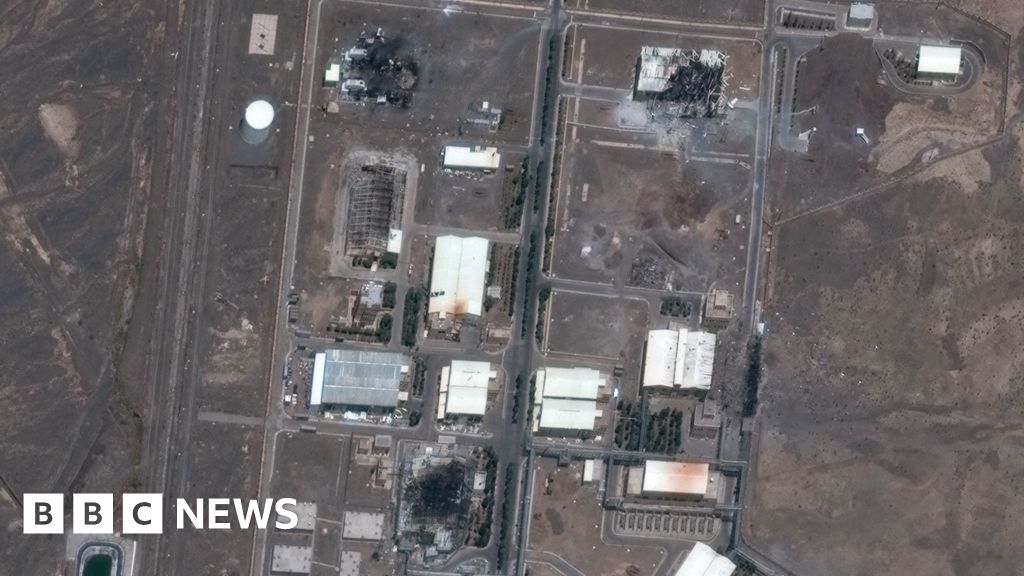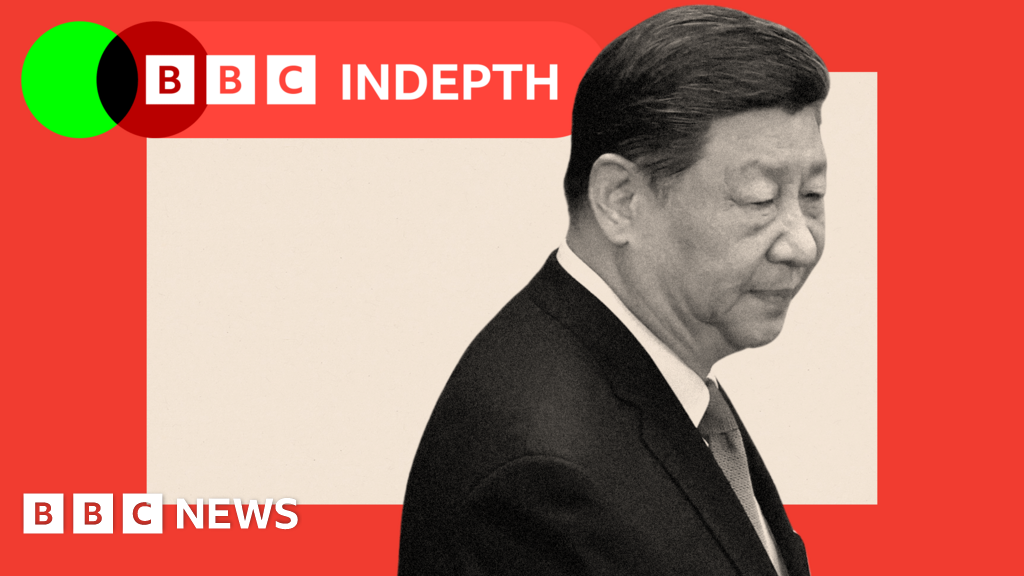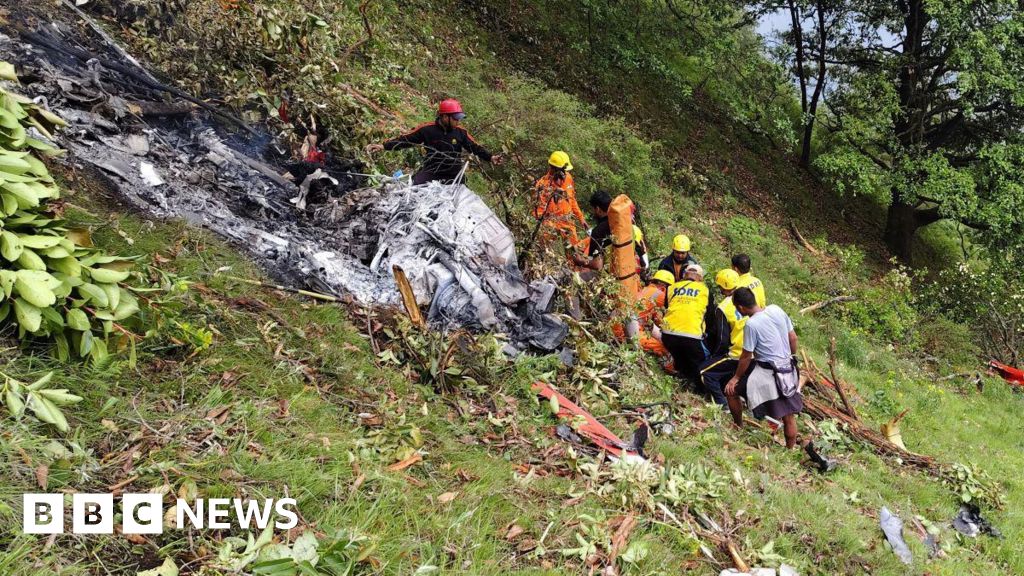
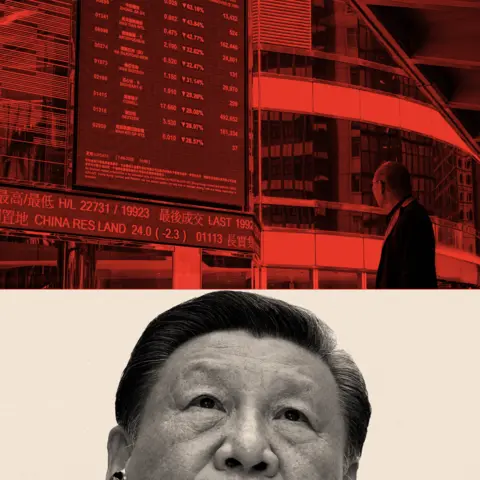 BBC
BBCIf you say the name Donald Trump in the halls of wholesale markets and trade fairs in China, you’ll hear a faint chuckle.
The US president and his 145% tariffs have not instilled fear in many Chinese traders.
Instead, they have inspired an army of online Chinese nationalists to create mocking memes in a series of viral videos and reels – some of which include an AI-generated President Trump, Vice-President JD Vance and tech mogul Elon Musk toiling on footwear and iPhone assembly lines.
China is not behaving like a nation facing the prospect of economic pain and President Xi Jinping has made it clear that Beijing will not back down.
“For more than 70 years, China has always relied on self-reliance and hard work for development… it has never relied on anyone’s gifts and is unafraid of any unreasonable suppression,” he said this month.
His confidence may come in part because China is far less dependent than it was 10 years ago on exports to the US. But the truth is Trump’s brinkmanship and tariff hikes are pushing on pressure points that already exist within China’s own struggling economy. With a housing crisis, increasing job insecurity and an ageing population, Chinese people are simply not spending as much as their government would like.
Xi came to power in 2012 with a dream of a rejuvenated China. That is now being severely tested – and not just by US tariffs. Now, the question is whether or not Trump’s tariffs will dampen Xi’s economic dreams, or can he turn the obstacles that exist into opportunities?
Xi’s domestic challenges
With a population of 1.4 billion, China has, in theory, a huge domestic market. But there’s a problem. They don’t appear willing to spend money while the country’s economic outlook is uncertain.
This has not been prompted by the trade war – but by the collapse of the housing market. Many Chinese families invested their life savings in their homes, only to watch prices plummet in the last five years.
Housing developers continued to build even as the property market crumbled. It’s thought that China’s entire population would not fill all the empty apartments across the country.
The former deputy head of China’s statistics bureau, He Keng, admitted two years ago that the most “extreme estimate” is that there are now enough vacant homes for 3 billion people.
 Getty Images
Getty ImagesTravel round Chinese provinces and you see they are littered with empty projects – lines of towering concrete shells that have been labelled “ghost cities”. Others have been fitted out, the gardens have been landscaped, curtains frame the windows, and they appear filled with the promise of a new home. But only at night, when you see no lights, can you tell that the apartments are empty. There just aren’t enough buyers to match this level of construction.
The government acted five years ago to restrict the amount of money developers could borrow. But the damage to house prices and, in turn, consumer confidence in China, has been done and analysts have projected a 2.5% decline in home prices this year, according to a Reuters poll in February.
And it’s not just house prices that worry middle-class Chinese families.
They are concerned about whether the government can offer them a pension – over the next decade, about 300 million people, who are currently aged 50 to 60, are set to leave the Chinese workforce. According to a 2019 estimate by the state-run Chinese Academy of Social Sciences, the government pension fund could run out of money by 2035.
There are also fears about whether their sons, daughters and grandchildren can get a job as millions of college graduates are struggling to find work. More than one in five people between the ages of 16 and 24 in urban areas are jobless in China, according to official data published in August 2023. The government has not released youth unemployment figures since then.
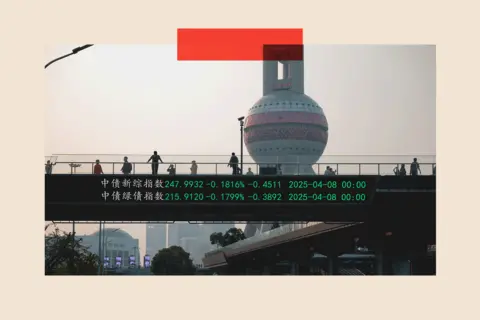 EPA – EFE/REX/Shutterstock
EPA – EFE/REX/ShutterstockThe problem is that China cannot simply flip a switch and move from selling goods to the US to selling them to local buyers.
“Given the downward pressure on the economy, it is unlikely domestic spending can be significantly expanded in the short term,” says Prof Nie Huihua at Renmin University.
“Replacing exports with internal demand will take time.”
According to Prof Zhao Minghao, deputy director of the Center for American Studies at Fudan University, “China does not have high expectations for talks with the Trump administration… The real battleground is in the adjustment of China’s domestic policies, such as boosting domestic demand.”
To revive a slowing economy, the government has announced billions in childcare subsidies, increased wages and better paid leave. It has also introduced a $41bn programme offering discounts on items such as consumer electronics and electric vehicles (EVs) to encourage more people to spend. But Prof Zhang Jun, the Dean of Economics at Fudan University, believes this is not “sustainable”.
“We need a long-term mechanism,” he says. “We need to start increasing residents’ disposable income.”
This is urgent for Xi. The dream of prosperity he sold when he took power 13 years ago has not become reality.
A political test for Xi
Xi is also aware that China has a disheartened younger generation worried about their future. That could spell bigger trouble for the Communist Party: protests or unrest.
A report by Freedom House’s China Dissent Monitor claims that protests driven by financial grievances saw a steep increase in the last few months.
All protests are quickly subdued and censored on social media, so it is unlikely to pose a real threat to Xi for now.
“Only when the country does well and the nation does well can every person do well,” Xi said in 2012.
This promise was made when China’s economic rise looked unstoppable. It now looks uncertain.
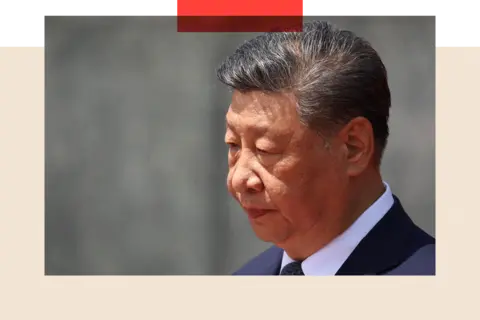 Getty Images
Getty ImagesWhere the country has made huge strides over the past decade is in areas such as consumer electronics, batteries, EVs and artificial intelligence as part of a pivot to advanced manufacturing.
It has rivalled US tech dominance with the chatbot DeepSeek and BYD, which beat Tesla last year to become the world’s largest EV maker.
Yet Trump’s tariffs threaten to throw a spanner in the works.
The restrictions on the sale of key chips to China, including the most recent move tightening exports from US chip giant Nvidia, for instance, are aimed at curbing Xi’s ambitions for tech supremacy.
Despite that, Xi knows that Chinese manufacturers are at a decades-long advantage, so that US manufacturers are struggling to find the same scale of infrastructure and skilled labour elsewhere.
Turning a challenge into an opportunity
President Xi is also trying to use this crisis as a catalyst for further change and to find more new markets for China.
“In the short term, some Chinese exporters will be greatly impacted,” says Prof Zhang. “But Chinese companies will take the initiative to adjust the destination of exports to overcome difficulties. Exporters are waiting and looking for new customers.”
Donald Trump’s first term in office was China’s cue to look elsewhere for buyers. It has expanded its ties across South East Asia, Latin America and Africa – and a Belt and Road trade and infrastructure initiative shored up ties with the so-called Global South.
China is reaping the rewards from that diversification. More than 145 countries do more trade with China than they do with the US, according to the Lowy Institute.
In 2001, only 30 countries chose Beijing as their lead trade partner over Washington.
Geopolitical gains
As Trump targets both friend and foe, some believe Xi can further upend the current US-led world order and portray his country as a stable, alternative global trade partner and leader.
The Chinese leader chose South East Asia for his first trip abroad after the tariff announcement, sensing his neighbours would be getting jittery about Trump’s tariffs.
Around a quarter of Chinese exports are now manufactured or shipped through a second country including Vietnam and Cambodia.
Recent US actions may also present a chance for Xi to positively shape China’s role in the world.
“Trump’s coercive tariff policy is an opportunity for Chinese diplomacy,” says Prof Zhang.
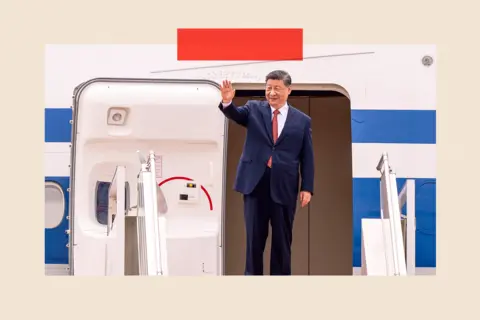 Getty Images
Getty ImagesChina will have to tread carefully. Some countries will be nervous that products being manufactured for the US could end up flooding into their markets.
Trump’s tariffs in 2016 sent a glut of cheap Chinese imports, originally intended for the US, into South East Asia, hurting many local manufacturers.
According to Prof Huihua, “about 20% of China’s exports go to the US – if these exports were to flood any regional market or country, it could lead to dumping and vicious competition, thereby triggering new trade frictions”.
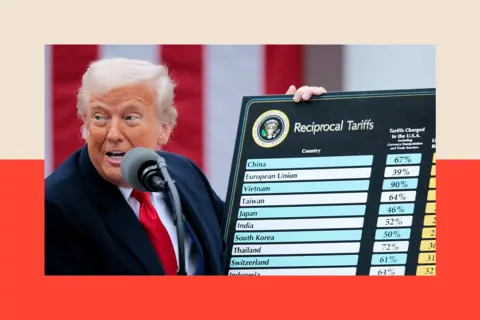 Getty Images
Getty ImagesThere are barriers to Xi presenting himself as the arbiter of free trade in the world.
China has subjected other nations to trade restrictions in recent years.
In 2020, after the Australian government called for a global inquiry into the origins and early handling of the Covid pandemic, which Beijing argued was a political manoeuvre against them, China placed tariffs on Australian wine and barley and imposed biosecurity measures on some beef and timber and bans on coal, cotton and lobster. Some Australian exports of certain goods to China fell to nearly zero.
Australia’s Defence Minister Richard Marles said earlier this month that his nation will not be “holding China’s hand” as Washington escalated its trade war with Beijing.
China’s past actions may impede Xi’s current global outreach and many countries may be unwilling to choose between Beijing and Washington.
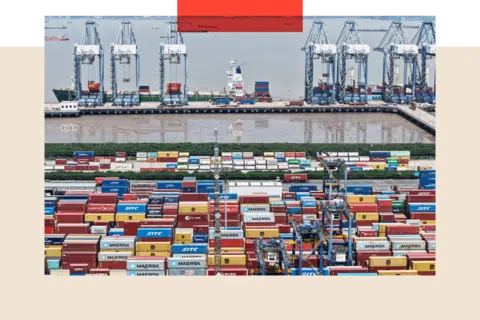 Getty Images
Getty ImagesEven with all the various difficulties, Xi is betting that Beijing will be able to withstand any economic pain longer than Washington in this great power competition.
And it does appear that Trump has blinked first, last week hinting at a potential U-turn on tariffs, saying that the taxes he has so far imposed on Chinese imports would “come down substantially, but it won’t be zero”.
Meanwhile, Chinese social media is back in action.
“Trump has chickened out,” was one of the top trending search topics on the Chinese social media platform Weibo after the US president softened his approach to tariffs.
Even if or when talks do happen, China is playing a longer game.
The last trade war forced it to diversify its export market away from the US towards other markets – especially in the Global South.
This trade war has China looking in the mirror to see its own flaws – and whether it can fix them will be up to policies made in Beijing, not Washington.
Top picture credit: Getty Images
BBC InDepth is the home on the website and app for the best analysis, with fresh perspectives that challenge assumptions and deep reporting on the biggest issues of the day. And we showcase thought-provoking content from across BBC Sounds and iPlayer too. You can send us your feedback on the InDepth section by clicking on the button below.
Source link





